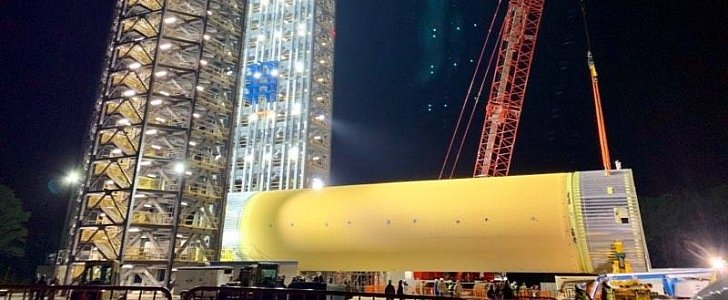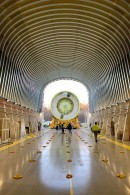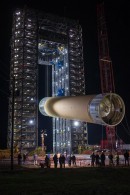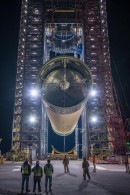NASA’s brand new super-heavy-lift rocket, the Space Launch System, is on track with the development process that will eventually lead to a to a test flight sometime after 2020.
This week, the America space agency released photos showing the rocket’s huge liquid hydrogen tank being put upright into Test Stand 4693 at NASA’s Marshall Space Flight Center in Huntsville, Alabama, for a series of tests.
As soon as the component – the biggest of the future SLS – got in position, dozens of hydraulic cylinders began pushing and pulling at it in an attempt to mimic the loads and stress the tank will be subject to during launch and flight.
The tank sitting upright in Alabama is not the actual one that will be fitted into the SLS, but one “structurally identical to the flight version.” It is 200 feet tall and has a diameter of 27.6 feet, being capable of storing cryogenic liquid hydrogen and liquid oxygen.
According to NASA, this disposable tank makes for two-thirds of the core stage and has a storage capacity of 537,000 gallons of hydrogen, kept at temperatures of minus 423 degrees Fahrenheit (-253 Celsius).
The completed SLS is NASA’S response to private companies like SpaceX and their attack on space exploration, including with heavy-lift rockets. It is being assembled with the help of Boeing, United Launch Alliance, Northrop Grumman, and Aerojet Rocketdyne.
The rocket will push into outer space NASA’s Orion spacecraft, which is being developed at a fast pace. The combo is scheduled to launch with no crew in 2020, only to be followed two years later by crewed missions. The ultimate goal of the SLS-Orion is to take humans to Mars orbit and a later date allow them to land on the Red Planet.
Aside for launching humans, the SLS will also send an orbiter towards one of Jupiter’s moons, Europa, in 2022.
As soon as the component – the biggest of the future SLS – got in position, dozens of hydraulic cylinders began pushing and pulling at it in an attempt to mimic the loads and stress the tank will be subject to during launch and flight.
The tank sitting upright in Alabama is not the actual one that will be fitted into the SLS, but one “structurally identical to the flight version.” It is 200 feet tall and has a diameter of 27.6 feet, being capable of storing cryogenic liquid hydrogen and liquid oxygen.
According to NASA, this disposable tank makes for two-thirds of the core stage and has a storage capacity of 537,000 gallons of hydrogen, kept at temperatures of minus 423 degrees Fahrenheit (-253 Celsius).
The completed SLS is NASA’S response to private companies like SpaceX and their attack on space exploration, including with heavy-lift rockets. It is being assembled with the help of Boeing, United Launch Alliance, Northrop Grumman, and Aerojet Rocketdyne.
The rocket will push into outer space NASA’s Orion spacecraft, which is being developed at a fast pace. The combo is scheduled to launch with no crew in 2020, only to be followed two years later by crewed missions. The ultimate goal of the SLS-Orion is to take humans to Mars orbit and a later date allow them to land on the Red Planet.
Aside for launching humans, the SLS will also send an orbiter towards one of Jupiter’s moons, Europa, in 2022.









